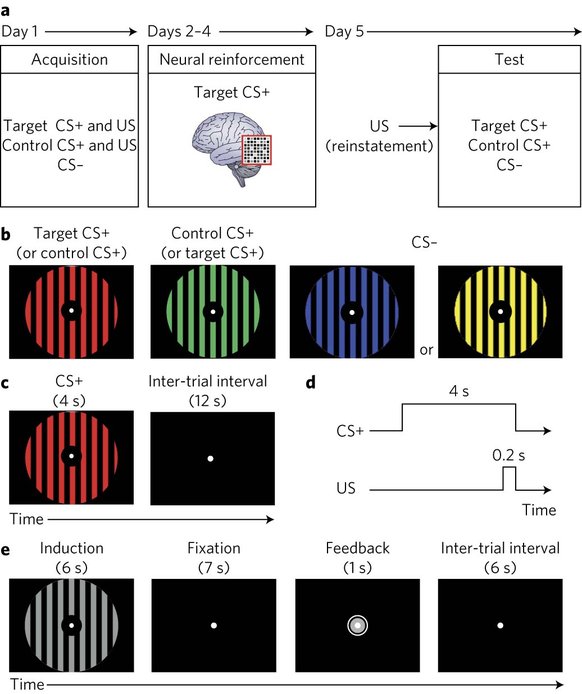恐怖対象への意識的な暴露を伴わない脳活動の強化学習による恐怖反応緩和
Fear reduction without fear through reinforcement of neural activity that bypasses conscious exposure
2016年11月21日 Nature Human Behaviour 1 : 6 doi: 10.1038/s41562-016-0006

恐怖条件付けは生存を支える重要な過程であり、種を超えて保存されている。ヒトでは、恐怖症や心的外傷後ストレス障害(PTSD)など、恐怖に関わる障害と関連している。恐怖記憶は、恐怖条件付け刺激(CS+)とともに報酬または新規の非脅威刺激を繰り返し与える反対条件付けによって緩和することができる。しかしこの方法では、恐怖が緩和する前に、対象者が強く嫌悪するCS+を意識的に知覚させることになる。こうした嫌悪が、実験パラダイムを臨床に応用する際の妨げとなる可能性がある。では、恐怖を緩和するために恐怖の対象を意識的に知覚させる必要はあるのだろうか。刺激を意識的に知覚させなくても学習が成立することは過去に証明されているもののCS+への明示的な暴露を避けながら恐怖を緩和できるかどうかはほとんどわかっていない。近年、刺激を明示的に提示することなく学習を誘導する新たな手法(デコーディッドニューロフィードバック法:DecNef)が開発された。この手法では、刺激を提示することなく、多変量fMRI(機能的磁気共鳴画像法)信号の空間的パターンをリアルタイムに解読し、特定の刺激と一致する脳活動パターンが生じたときに被験者に報酬を与え、CS+の神経表現を強化する。DecNefを用いれば、被験者に、特定の神経表現を誘導するための戦略を与えることも、強化された神経表現の内容を意識させることもなく、特定の視覚刺激図形に対する知覚学習を起こせることが明らかとなっている。今回我々は、同様の手法を恐怖の反対条件付けに適用した。その結果、CS+を表現する視覚野の脳活動パターンに報酬を組み合わせることで、被験者にDecNefの目的を意識させることなく、CS+への恐怖を緩和することができた。この手法は、無意識的な情報処理を利用して恐怖症やPTSDなどの恐怖に関連した障害を治療する新たな第一歩となる可能性がある。

